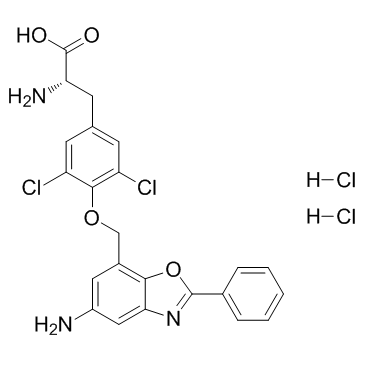| Description |
JPH203 Dihydrochloride is a tyrosine analog, acts as a selective inhibitor of L-type amino acid transporter 1 (LAT1), and is used in cancer research.
|
| Related Catalog |
|
| Target |
LAT1[1]
|
| In Vitro |
JPH203 Dihydrochloride is a selective inhibitor of LAT1. JPH203 (KYT-0353) inhibits 14C-leucine uptake in S2-hLAT1 and HT-29 cells, with IC50s of 0.14 μM and 0.06 μM. JPH203 (3-1000 μM) exhibits concentration-dependent inhibitory effects on S2-hLAT1 cell growth with an IC50 of 16.4 μM. JPH203 also displays inhibitory activities against HT-29 cell growth, with an IC50 value of 4.1 μM[1]. JPH203 (0.001-100 μM) inhibits the 14C-leucine (1.0 μM) uptake in a concentration dependent way by the YD-38 cells with an IC50 value of 0.79 ± 0.06 μM. JPH203 slightly shows such effects in normal human oral keratinocytes (NHOKs). JPH203 (0.01-30 mM, 1-4 d) completely inhibits the proliferation of YD-38 cells in a dose- and time-dependent manner. However, JPH203 slightly inhibits the proliferation of NHOKs. JPH203 (30 mM) induces apoptosis of YD-38 cells. JPH203 (3 mM) also increases the level of cleaved PARP in activation of the caspases cascade[2]. JPH203 (30 mM) induces mitochondria-dependent apoptosis in Saos2 human osteosarcoma cells. JPH203 (0.001-100 µM) inhibits 14C-leucine (1.0 µM) uptake slightly in FOB cells with an IC50 value of 92.12 ± 10.71 µM, but potently exihibts such effects in Saos2 cells with an IC50 value of 1.31 ± 0.27 µM. JPH203 (0.01 to 30 mM, 1-4 d) potently inhibits cell proliferation in Saos2 cells in a dose- and time-dependent manner, with an IC50 of 4.09-0.09 mM, but slightly inhibits that of FOB cells, with an IC50 of 24.1-2.8 mM[3].
|
| In Vivo |
JPH203 (6.3, 12.5, and 25.0 mg/kg, i.v. for 14 days) exhibits dose-dependent inhibition on HT-29 tumor growth in nude mice[1].
|
| Cell Assay |
Growth inhibition is evaluated by the MTT assay method. Namely, cell suspensions (1 × 104 cells/mL) in a volume of 135 μL are placed into the wells of a flat-bottom 96-well microtiter plate, and incubated in the atmosphere of 5% CO2 at 37°C (24 h). Drug solutions (15 μL) at various concentrations are added and incubated (96 h) under the same conditions. Next, MTT (15 μL; 5 mg/mL) dissolved in PBS is added and incubated (4.0 h). The incubation medium containing MTT is aspirated off. Cells are mixed (5 min) with DMSO (200 μL) and optical density read (540 nm) using a microtiter plate reader Emax; subsequently, IC50 values are determined[1].
|
| Animal Admin |
Human-derived nude mouse HT-29 tumor growth inhibition is evaluated. HT-29 tumor blocks are injected subcutaneously to the right flank of male nude mice. After tumor volumes reach 100 to 300 mm3, the mice are divided into groups (n = 6). On the day of grouping (day 0), test compounds (JPH203) are administered intravenously daily for 14 days at three different doses (6.3, 12.5, and 25.0 mg/kg). Tumor volumes and body weights are measured two or three times a week for 42 days. Tumor volumes are expressed relative to initial tumor volume (day 0). Growth inhibition ratios for each treatment group is obtained from the mean tumor volume of the treated group compared to that of the control group[1].
|
| References |
[1]. Oda K, et al. L-type amino acid transporter 1 inhibitors inhibit tumor cell growth. Cancer Sci. 2010 Jan;101(1):173-9. [2]. Yun DW, et al. JPH203, an L-type amino acid transporter 1-selective compound, induces apoptosis of YD-38 human oral cancer cells. J Pharmacol Sci. 2014;124(2):208-17. Epub 2014 Feb 4. [3]. Choi DW, et al. JPH203, a selective L-type amino acid transporter 1 inhibitor,Choi DW, et al. JPH203, a selective L-type amino acid transporter 1 inhibitor, induces mitochondria-dependent apoptosis in Saos2 human osteosarcoma cells. Korean J Physiol Pharmacol. 2017 Nov;21(6):599-607.
|
